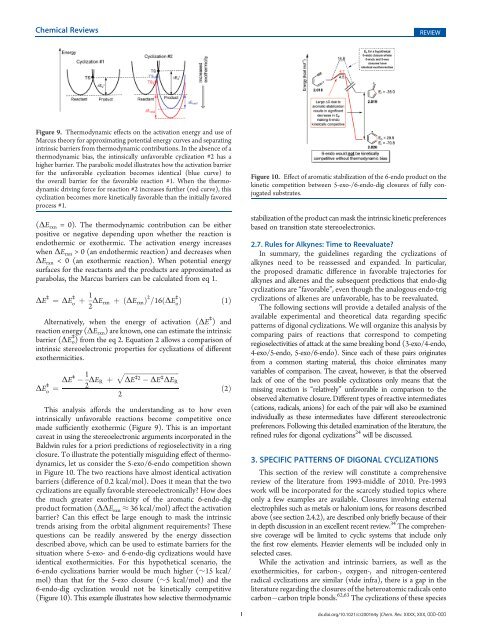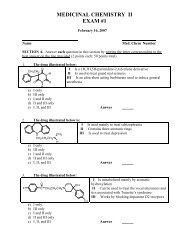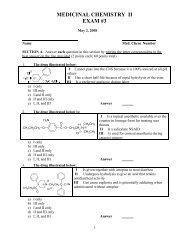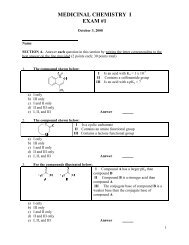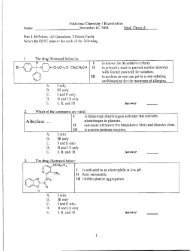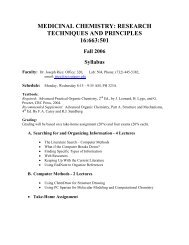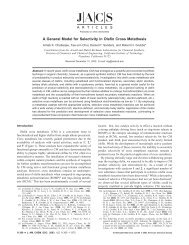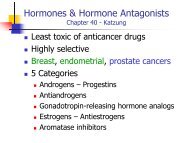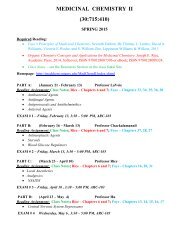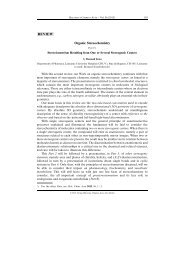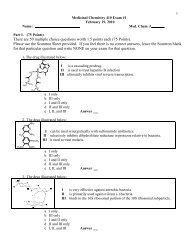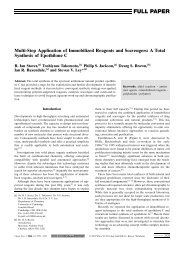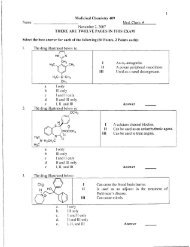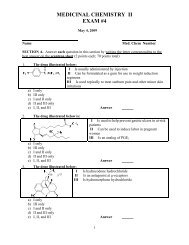Baldwin's Rules - Department of Medicinal Chemistry
Baldwin's Rules - Department of Medicinal Chemistry
Baldwin's Rules - Department of Medicinal Chemistry
You also want an ePaper? Increase the reach of your titles
YUMPU automatically turns print PDFs into web optimized ePapers that Google loves.
Chemical Reviews REVIEW<br />
Figure 9. Thermodynamic effects on the activation energy and use <strong>of</strong><br />
Marcus theory for approximating potential energy curves and separating<br />
intrinsic barriers from thermodynamic contributions. In the absence <strong>of</strong> a<br />
thermodynamic bias, the intinsically unfavorable cyclization #2 has a<br />
higher barrier. The parabolic model illustrates how the activation barrier<br />
for the unfavorable cyclization becomes identical (blue curve) to<br />
the overall barrier for the favorable reaction #1. When the thermodynamic<br />
driving force for reaction #2 increases further (red curve), this<br />
cyclization becomes more kinetically favorable than the initially favored<br />
process #1.<br />
(ΔE rxn = 0). The thermodynamic contribution can be either<br />
positive or negative depending upon whether the reaction is<br />
endothermic or exothermic. The activation energy increases<br />
when ΔE rxn > 0 (an endothermic reaction) and decreases when<br />
ΔErxn < 0 (an exothermic reaction). When potential energy<br />
surfaces for the reactants and the products are approximated as<br />
parabolas, the Marcus barriers can be calculated from eq 1.<br />
ΔE q ¼ ΔE q 1<br />
o þ<br />
2 ΔErxn þðΔErxnÞ 2 =16ðΔE q oÞ ð1Þ<br />
Alternatively, when the energy <strong>of</strong> activation (ΔE q ) and<br />
reaction energy (ΔErxn) are known, one can estimate the intrinsic<br />
barrier (ΔEo q ) from the eq 2. Equation 2 allows a comparison <strong>of</strong><br />
intrinsic stereoelectronic properties for cyclizations <strong>of</strong> different<br />
exothermicities.<br />
ΔE q o ¼<br />
ΔEq 1<br />
2 ΔER þ ffiffiffiffiffiffiffiffiffiffiffiffiffiffiffiffiffiffiffiffiffiffiffiffiffiffiffiffiffiffiffiffi<br />
ΔEq2 ΔEq p<br />
ΔER<br />
ð2Þ<br />
2<br />
This analysis affords the understanding as to how even<br />
intrinsically unfavorable reactions become competitive once<br />
made sufficiently exothermic (Figure 9). This is an important<br />
caveat in using the stereoelectronic arguments incorporated in the<br />
Baldwin rules for a priori predictions <strong>of</strong> regioselectivity in a ring<br />
closure. To illustrate the potentially misguiding effect <strong>of</strong> thermodynamics,<br />
let us consider the 5-exo/6-endo competition shown<br />
in Figure 10. The two reactions have almost identical activation<br />
barriers (difference <strong>of</strong> 0.2 kcal/mol). Does it mean that the two<br />
cyclizations are equally favorable stereoelectronically? How does<br />
the much greater exothermicity <strong>of</strong> the aromatic 6-endo-dig<br />
product formation (ΔΔErxn ≈ 36 kcal/mol) affect the activation<br />
barrier? Can this effect be large enough to mask the intrinsic<br />
trends arising from the orbital alignment requirements? These<br />
questions can be readily answered by the energy dissection<br />
described above, which can be used to estimate barriers for the<br />
situation where 5-exo- and 6-endo-dig cyclizations would have<br />
identical exothermicities. For this hypothetical scenario, the<br />
6-endo cyclizations barrier would be much higher (∼15 kcal/<br />
mol) than that for the 5-exo closure (∼5 kcal/mol) and the<br />
6-endo-dig cyclization would not be kinetically competitive<br />
(Figure 10). This example illustrates how selective thermodynamic<br />
Figure 10. Effect <strong>of</strong> aromatic stabilization <strong>of</strong> the 6-endo product on the<br />
kinetic competition between 5-exo-/6-endo-dig closures <strong>of</strong> fully conjugated<br />
substrates.<br />
stabilization <strong>of</strong> the product can mask the intrinsic kinetic preferences<br />
based on transition state stereoelectronics.<br />
2.7. <strong>Rules</strong> for Alkynes: Time to Reevaluate?<br />
In summary, the guidelines regarding the cyclizations <strong>of</strong><br />
alkynes need to be reassessed and expanded. In particular,<br />
the proposed dramatic difference in favorable trajectories for<br />
alkynes and alkenes and the subsequent predictions that endo-dig<br />
cyclizations are “favorable”, even though the analogous endo-trig<br />
cyclizations <strong>of</strong> alkenes are unfavorable, has to be reevaluated.<br />
The following sections will provide a detailed analysis <strong>of</strong> the<br />
available experimental and theoretical data regarding specific<br />
patterns <strong>of</strong> digonal cyclizations. We will organize this analysis by<br />
comparing pairs <strong>of</strong> reactions that correspond to competing<br />
regioselectivities <strong>of</strong> attack at the same breaking bond (3-exo/4-endo,<br />
4-exo/5-endo, 5-exo/6-endo). Since each <strong>of</strong> these pairs originates<br />
from a common starting material, this choice eliminates many<br />
variables <strong>of</strong> comparison. The caveat, however, is that the observed<br />
lack <strong>of</strong> one <strong>of</strong> the two possible cyclizations only means that the<br />
missing reaction is “relatively” unfavorable in comparison to the<br />
observed alternative closure. Different types <strong>of</strong> reactive intermediates<br />
(cations, radicals, anions) for each <strong>of</strong> the pair will also be examined<br />
individually as these intermediates have different stereoelectronic<br />
preferences. Following this detailed examination <strong>of</strong> the literature, the<br />
refined rules for digonal cyclizations 24 will be discussed.<br />
3. SPECIFIC PATTERNS OF DIGONAL CYCLIZATIONS<br />
This section <strong>of</strong> the review will constitute a comprehensive<br />
review <strong>of</strong> the literature from 1993-middle <strong>of</strong> 2010. Pre-1993<br />
work will be incorporated for the scarcely studied topics where<br />
only a few examples are available. Closures involving external<br />
electrophiles such as metals or halonium ions, for reasons described<br />
above (see section 2.4.2), are described only brieflybecause<strong>of</strong>their<br />
in depth discussion in an excellent recent review. 34 The comprehensive<br />
coverage will be limited to cyclic systems that include only<br />
the first row elements. Heavier elements will be included only in<br />
selected cases.<br />
While the activation and intrinsic barriers, as well as the<br />
exothermicities, for carbon-, oxygen-, and nitrogen-centered<br />
radical cyclizations are similar (vide infra), there is a gap in the<br />
literature regarding the closures <strong>of</strong> the heteroatomic radicals onto<br />
carbon carbon triple bonds. 62,63 The cyclizations <strong>of</strong> these species<br />
I dx.doi.org/10.1021/cr200164y |Chem. Rev. XXXX, XXX, 000–000


